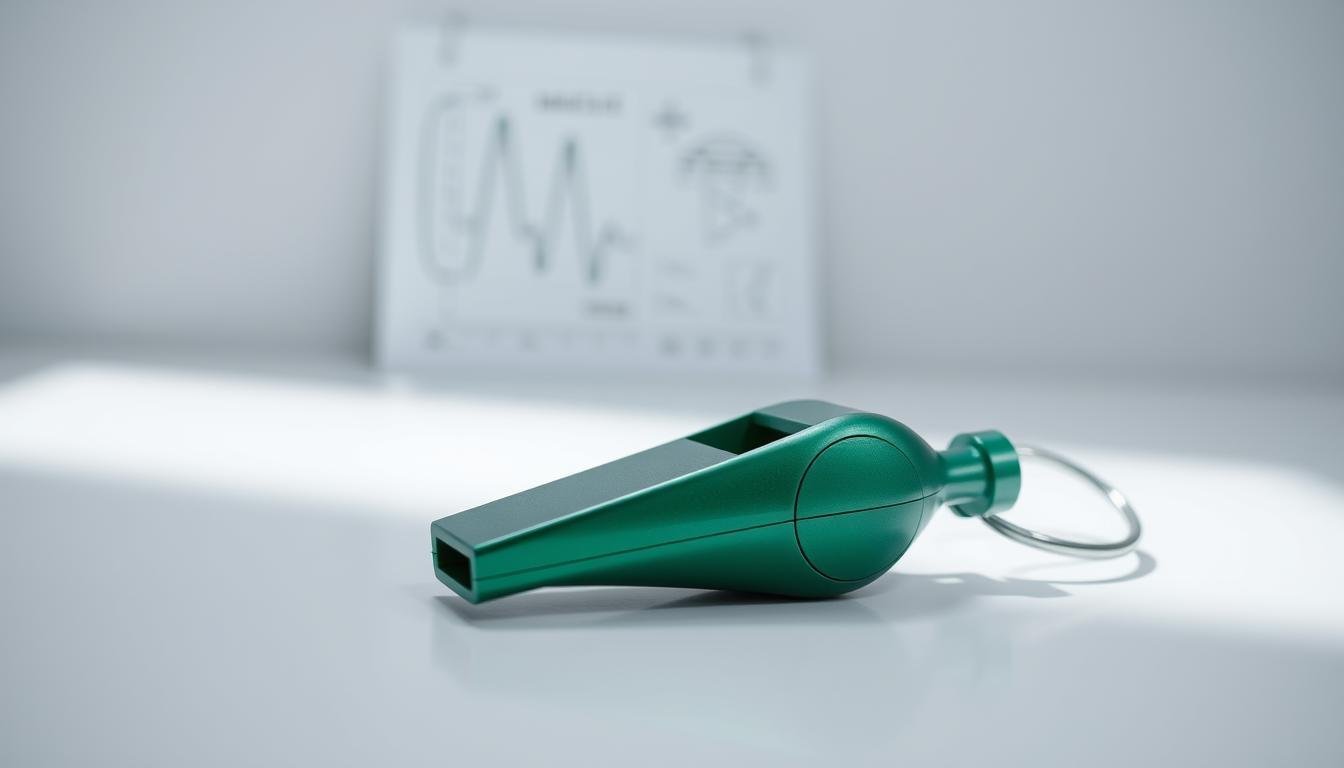Have you heard of the Green Whistle, a device for pain relief? You might wonder why it’s not in the US.
The Green Whistle, also known as Penthrox, has sparked debate. People are worried about its safety and how well it works.
Looking into why it’s banned, you’ll find it’s a complex issue. It involves rules and disagreements among doctors.
Learning about the Green Whistle’s past and why it’s not in the US is enlightening. It shows how tricky medical device rules can be.
Contents
- 1 What is the Green Whistle?
- 2 Why is the Green Whistle Banned in the US?
- 3 Medical and Safety Concerns
- 4 Alternative Pain Management Options in the US
- 5 Conclusion
- 6 FAQ
- 6.1 What is the Green Whistle used for?
- 6.2 How is the Green Whistle administered?
- 6.3 Why is the Green Whistle banned in the US?
- 6.4 What are the alternative pain management options in the US?
- 6.5 What are the potential risks and side effects of using the Green Whistle?
- 6.6 Are there any comparative safety studies on the Green Whistle?
- 6.7 Can the Green Whistle be used for chronic pain management?
- 6.8 Is the Green Whistle available in other countries?
What is the Green Whistle?
Are you new to the Green Whistle? It’s a tool for pain relief, also known as Penthrox. This device uses methoxyflurane, a powerful painkiller, in medical settings.
Methoxyflurane is the key ingredient in Penthrox. It’s a strong painkiller that’s been around for years. The Green Whistle is made to be portable and simple to use. It’s great for emergency situations and other times when pain needs to be managed fast.
Administration Method
The Green Whistle works by inhalation. Patients breathe in the methoxyflurane through a small device. This way, pain relief starts quickly.
The device also has a safety feature to stop too much use. It controls how much methoxyflurane is inhaled. This keeps patients safe.
Penthrox is used in many medical situations, like emergencies and during procedures. Doctors like it because it works well to ease pain. It’s especially popular in some areas.
| Key Features | Description | Benefits |
|---|---|---|
| Portability | The device is compact and lightweight. | Ease of use in various settings. |
| Administration Method | Inhalation through a handheld device. | Rapid onset of analgesia. |
| Safety Mechanism | Built-in mechanism to prevent excessive dosing. | Enhanced patient safety. |
Knowing about the Green Whistle helps us see its importance in managing pain. As we learn more, we’ll understand why it’s regulated in the US.
Why is the Green Whistle Banned in the US?
Many wonder why the Green Whistle, a well-known pain relief drug, is banned in the US. The main reason is the strict rules of the US pharmaceutical market. This includes the US FDA’s oversight.
The Green Whistle, also known as Penthrox, is a methoxyflurane-based inhaler for pain relief. It’s popular in other countries but not in the US. The US FDA hasn’t approved it due to safety and effectiveness concerns.
The US FDA has a detailed approval process. It includes pre-clinical trials, clinical trials, and a thorough review of safety and effectiveness data.
FDA Approval Process
The FDA approval process ensures drugs are safe and work well. It involves several steps:
- Pre-clinical trials: First, tests are done in labs and on animals to check safety and potential benefits.
- Clinical trials: The drug is tested on humans in different phases to see if it’s safe and works well.
- New Drug Application (NDA): The maker sends an NDA to the FDA with all trial data.
- FDA Review: The FDA checks the NDA, inspects facilities, and reviews data to decide if the drug is safe and effective.
The Green Whistle’s maker has struggled with the FDA’s approval process. They’ve had trouble addressing the FDA’s concerns about the drug’s risks.
One big worry is nephrotoxicity, or kidney damage, linked to methoxyflurane. Although the risk is low with careful use, the FDA has been cautious.
So, the Green Whistle is banned in the US. Patients and healthcare providers must look for other pain relief options.
Medical and Safety Concerns
The Green Whistle has faced scrutiny for its potential risks and side effects. The medical community has raised several concerns about its safety. These concerns are especially true when compared to other pain management options in the US.
The main worry is the Green Whistle’s potential for abuse and the risks of its active ingredients. Penthrox, the active component, is a methoxyflurane-based analgesic. It is effective for short-term pain relief but poses risks with prolonged or improper use.
Comparative Safety Studies
Studies have compared the Green Whistle’s safety with other pain management devices and medications. These studies have shown differences in safety profiles. They highlight the risk of adverse effects and the potential for dependency.
| Device/Medication | Risk of Dependency | Common Side Effects |
|---|---|---|
| Green Whistle (Penthrox) | Low to Moderate | Dizziness, Nausea, Headache |
| Oral Morphine | High | Constipation, Drowsiness, Nausea |
| Nitrous Oxide | Low | Dizziness, Confusion, Nausea |
Comparative safety studies show the Green Whistle has a relatively favorable safety profile. However, it is not without risks. Dizziness and nausea are notable side effects that healthcare providers consider when prescribing or administering this device.

In conclusion, the medical and safety concerns about the Green Whistle are complex. They involve the device’s potential risks and comparisons with other pain management strategies. Understanding these concerns is crucial for healthcare providers and patients to make informed decisions about pain management.
Alternative Pain Management Options in the US
If you’re looking for alternatives to the Green Whistle, the US has many options. The US healthcare system offers a wide range of devices and techniques for pain management.
There are different pain management strategies to explore. These include medicines like NSAIDs, opioids, and corticosteroids. Each has its own purpose and is used based on the pain type and severity.
Non-pharmacological techniques are also popular and recommended for some pains. These methods can be used alone or with medicines.
Non-Pharmacological Pain Management Techniques
Non-pharmacological techniques include physical therapy, cognitive-behavioral therapy (CBT), acupuncture, and medical devices. Physical therapy helps improve mobility and reduce pain with exercises. CBT changes how you see pain, helping you cope.
Acupuncture uses fine needles in specific body points to stimulate healing and pain relief. Medical devices like TENS units also help manage pain. They send electrical impulses to nerves, blocking pain signals to the brain.
It’s important to talk to healthcare professionals to find the best pain management for you. They can guide you through options and suggest a treatment plan that fits your needs.
Exploring these alternative pain management options can help you find relief without the Green Whistle. The US healthcare system provides a wide range of care for pain management, ensuring you get the help you need.
Conclusion
The Green Whistle, used for pain relief, has sparked debate due to its ban in the US. You’ve learned about its use, the reasons for the ban, and other pain management options.
The ban is mainly because of health and safety worries. Medical groups and regulators have questioned its safety and effectiveness. This led to its ban.
Understanding the ban means seeing it’s not just about the whistle. It’s also about safer, more effective alternatives. You can talk to your doctor about these options to manage pain well.
The ban highlights the need for careful testing and rules to protect us. Stay updated on such devices and their health effects.
FAQ
What is the Green Whistle used for?
The Green Whistle, also known as Penthrox, is a medical device for pain relief. It’s a methoxyflurane inhaler used to help with pain.
How is the Green Whistle administered?
The Green Whistle is given through inhalation. The patient breathes in the methoxyflurane vapor to feel pain relief.
Why is the Green Whistle banned in the US?
The Green Whistle is banned in the US because of safety and effectiveness concerns. There were also issues with the FDA approval process.
What are the alternative pain management options in the US?
In the US, there are many pain relief options. These include pain medications like opioids and non-opioids. There are also non-drug methods like acupuncture, physical therapy, and cognitive-behavioral therapy.
What are the potential risks and side effects of using the Green Whistle?
Using the Green Whistle can lead to risks and side effects. These include respiratory depression, drowsiness, and possible kidney damage from methoxyflurane.
Are there any comparative safety studies on the Green Whistle?
Yes, there have been studies comparing the Green Whistle’s safety to other pain management options. These studies have raised concerns about its safety.
Can the Green Whistle be used for chronic pain management?
The Green Whistle is not usually used for chronic pain. It’s mainly for acute pain relief, like in emergencies or during medical procedures.
Is the Green Whistle available in other countries?
Yes, the Green Whistle is available in countries like Australia and the UK. It’s used for pain relief in medical settings there.

Marcellus Stark is an investigative journalist from San Francisco, USA. He writes about global bans, rules, and unusual laws. He shares clear, interesting, and well-researched stories that help readers understand surprising facts worldwide.

